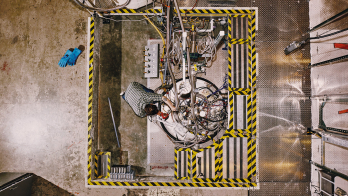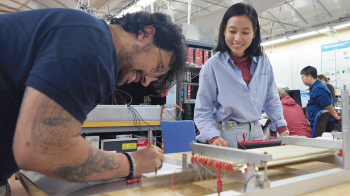An efficient new PET scanner for the small animal brain, developed by the Crystal Clear collaboration, is now in production.
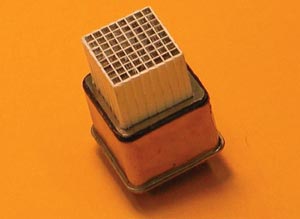
Crystal Clear is an international collaboration of research institutes, working to develop new generations of scanners for positron emission tomography (PET). The members are CERN, Forschungszentrum Jülich, the Institute of Nuclear Problems in Minsk, the Institute for Physical Research in Ashtarak, the Laboratório de Instrumentação e Física Experimental de Partículas (LIP) in Lisbon, Sungkyunkwan University School of Medicine in Seoul, the Université Claude Bernard in Lyon, the Université de Lausanne and the Vrije Universiteit Brussel (VUB).
Together with a number of guest laboratories, the institutes provide expertise in different domains of physics instrumentation, biology and medicine. Their research activities have led to the design and construction of three prototypes of a new generation of PET scanners for small animals, which provide depth-of-interaction (DOI) information. This machine has now been commercialized by the German company Raytest GmbH under the name ClearPET.
In PET, a molecule involved in a metabolic function of an organ or tumour is labelled by a positron-emitting radioisotope. Once injected, it is taken up by the cells or organs under study. The emitted positrons annihilate with electrons in the surrounding atoms to produce a back-to-back pair of gamma rays. Detecting this gamma radiation reveals the detailed distribution of the isotope.
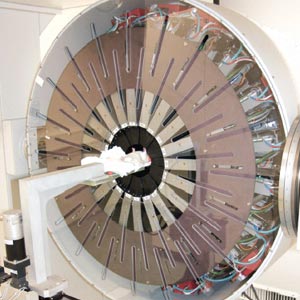
In the prototype scanners developed by the Crystal Clear collaboration, the detector heads are based on an 8 x 8 matrix of scintillation crystal elements, read out by a multi-anode photomultiplier tube (figure 1). Each element consists of a phosphor sandwich, or phoswich, made up of two layers of crystals with different decay times. One layer is formed from cerium-doped lutetium yttrium orthosilicate (LYSO) scintillator material; the other contains cerium-doped lutetium yttrium aluminate perovskite (LuYAP) scintillator, specially developed by the Crystal Clear collaboration and now commercially available from several companies.
The phoswich arrangement yields DOI information that can be used to correct parallax errors, resulting in a more uniform spatial resolution across the field of view. The crystal elements have an area of 2 x 2 mm and are 8 or 10 mm long; they are separated by 300 μm Tyvek, a highly reflecting material.
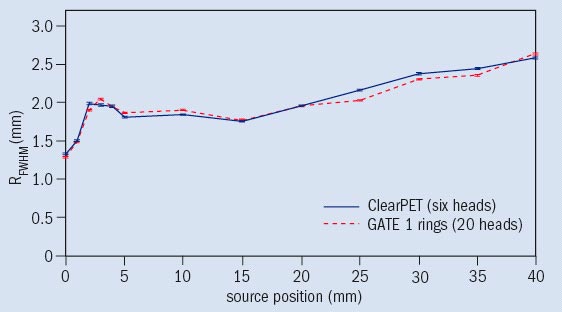
The detector modules, which are installed on a rotating gantry, consist of four detector heads mounted in line together with readout electronics. A complete ring system contains 20 detector modules. Because the gantry rotates during a scan, not all of the 20 need to be present. This allows the option of designing a cost-effective system based on a partial ring configuration. Two versions of the scanner are being produced, differing only in the mechanics of the gantry. ClearPETNeuro is optimized for small primates and features a gantry that can be tilted to allow the animal to be imaged in a sitting position, while ClearPET Rodent is optimized for rats and mice.
The performance of the ClearPET prototypes has been studied in various tests. The spatial resolution was measured by imaging a point source of the positron emitter 22Na. Figure 3 shows that the spatial resolution is close to the predictions made in detailed Monte Carlo simulations using GATE, the Geant4 Application for Tomographic Emission (CERN Courier January/February 2005 p27). At the centre of the field of view the resolution is 1.35 mm FWHM, and it remains constant around 1.8 mm FWHM for objects within 20 mm of the scanner axis.

A general feeling for the ClearPET’s performance was obtained by imaging a phantom – a model that measures the characteristics of a medical imaging system. An ad hoc Derenzo phantom was used, consisting of capillary tubes with diameters varying between 1.0 and 2.0 mm, arranged like slices in a pie. Rods of the phantom were filled with 0.5 mCi 18F, a positron emitter regularly used, for example, in PET scans of the brain. It was scanned for 6 min. Figure 4 shows a picture of the phantom and a reconstruction using the ordered-subsets expectation maximization (OSEM) method. Tubes with diameters as small as 1.6 mm are still clearly distinguishable.
The prototypes have also been tested with real subjects. Figure 5 (a) shows one of the rat images obtained with the ClearPETNeuro of the Forschungszentrum Jülich. A 400 g rat was injected with 0.5 mCi of 18F-labelled fluorodeoxyglucose ([18F]FDG), which can be used to observe sugar metabolism in the brain. A 24 min scan was started 30 min after the injection. The reconstructed image shows FDG uptake in the head of a rat. Figure 5 (b) depicts the anatomy of a rat brain. Note the good identification of the small olfactory bulb in front of the brain. These images were obtained using the library of Software for Tomographic Image Reconstruction (STIR) at Hammersmith Hospital, London.
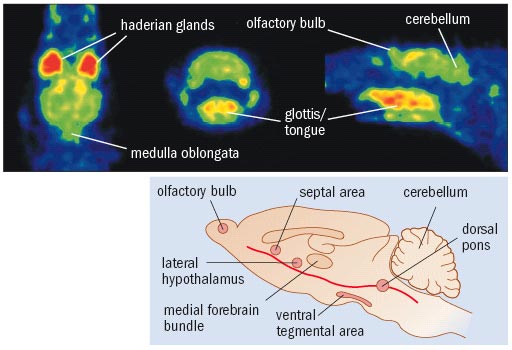
These measurements meet the ClearPET design specifications, and the first images obtained with a rat support these encouraging results. The ClearPETNeuro of the Forschungszentrum Jülich and the ClearPETRodent at the Vrije Universiteit Brussel are nearing completion, and will soon be used in several biomedical research projects.
• “ClearPET” has been registered as a trademark and the technology is licensed to Germany’s Raytest GmbH, which is commercializing a small animal PET system based on the ClearPET Rodent developed by Crystal Clear. See www.raytest.de/index2.html.
Further reading
For more on Crystal Clear, GATE or the STIR library, visit http://crystalclear.web.cern.ch/crystalclear, www.opengatecollaboration.org or http://stir.hammersmithimanet.com respectively.






